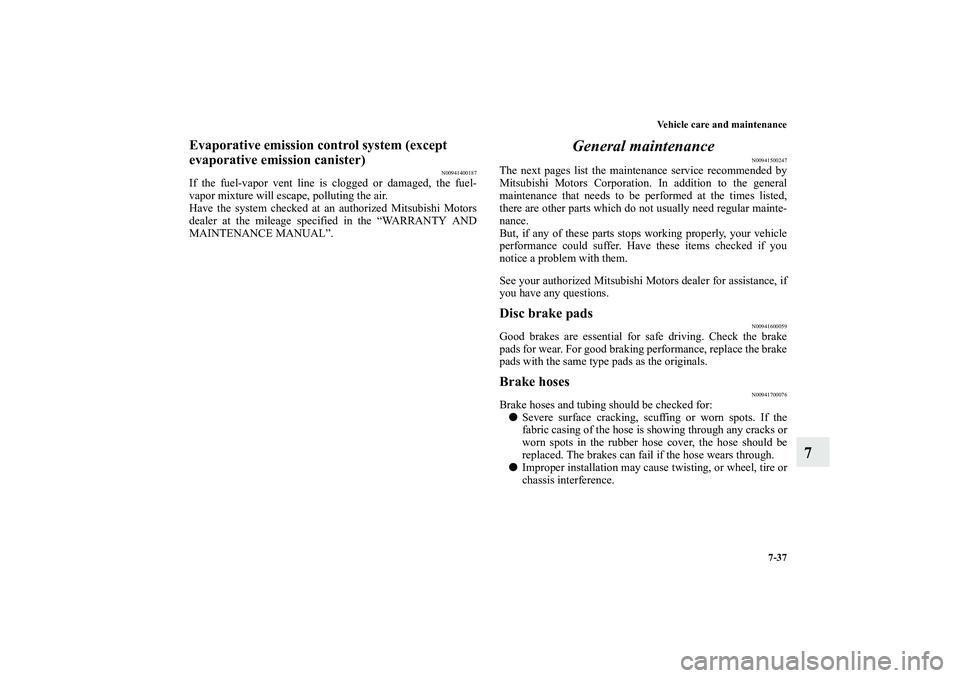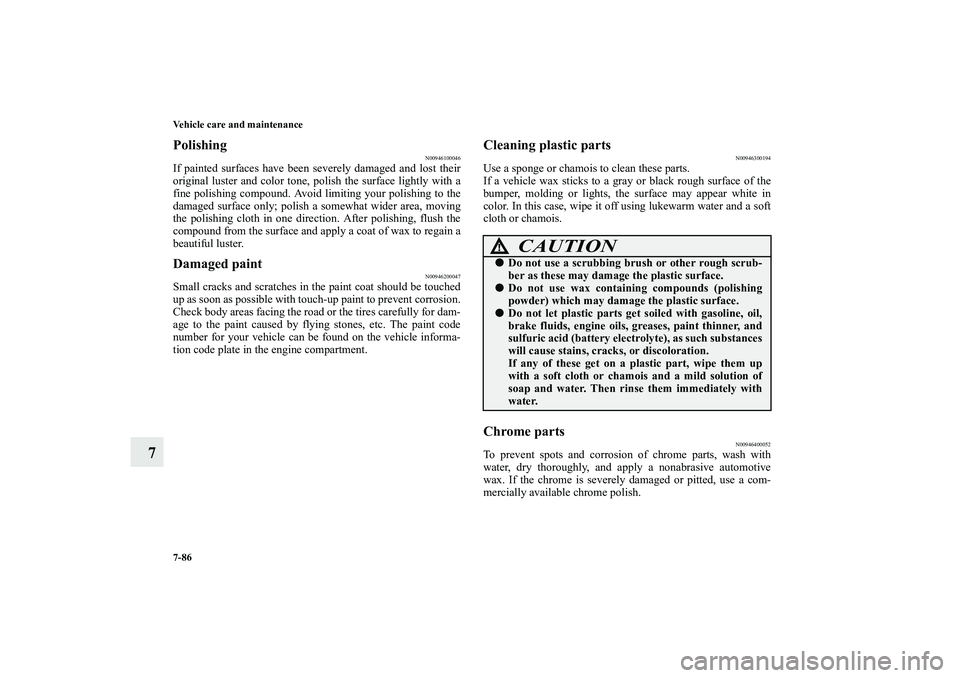Page 604 of 714
Vehicle care and maintenance
7-7
7 View of the engine compartment
N00937600579
2.4 L models 3.0 L models
1- Power steering fluid reservoir
2- Air cleaner filter
3- Brake fluid tank
4- Engine coolant reserve tank
5- Windshield and rear window washer fluid reservoir
6- Engine oil level dipstick
7- Engine oil filler cap
8- Radiator cap
9- Automatic transaxle fluid level dipstick
10- Battery
BK0122500US.book 7 ページ 2010年5月12日 水曜日 午前11時11分
Page 614 of 714
Vehicle care and maintenance
7-17
7
Procedure for checking the fluid level1. With the brake pedal fully depressed and the engine
idling, select each gear momentarily, ending with the
selector lever in the “P” (PARK) position.
2. The fluid level should be at the HOT mark, but never
above the HOT mark when the engine is warmed up. Add
or drain fluid to get to the correct level.
3. Make certain that the dipstick cap is installed properly to
keep dirt and water out of the transaxle.
Fluid typeUse only “DiaQueen ATF-J3” transaxle fluid to ensure opti-
mum transaxle performance.Special additivesMitsubishi Motors Corporation does not recommend the addi-
tion of any fluid additives to the transaxle.
WA R N I N G
!�Transaxle fluid is extremely flammable and poison-
ous. Do not spill fluid when adding or draining.
Good (Hot)
CAUTION
!�Using the improper transaxle fluid may damage the
transaxle.
BK0122500US.book 17 ページ 2010年5月12日 水曜日 午前11時11分
Page 617 of 714

7-20 Vehicle care and maintenance
7Brake fluid
N00938700203
To check the fluid levelCheck the fluid level in the reservoir.
The fluid level must be between the “MAX” and “MIN” marks
on the reservoir.
The fluid level falls slightly with wear of the brake pads, but
this does not indicate any abnormality.
If the fluid level falls markedly in a short length of time, it indi-
cates leaks from the brake system.
If this occurs, have the vehicle checked by an authorized Mit-
subishi Motors dealer or a repair facility of your choice.Fluid typeUse the recommended brake fluid conforming to DOT 3 or
DOT 4. The reservoir cap must be tightly sealed to keep dirt
and water out.
CAUTION
!�Do not let any petroleum-based fluid touch, mix
with, or get into the brake fluid. This will damage
the seals.�Be careful when handling brake fluid. It can damage
painted surfaces.�Use only the listed brake fluid. Different brands of
brake fluid have different additives, and these can
cause a chemical reaction. Do not mix brands of
brake fluid.�Keep the reservoir tank cap closed to keep the brake
fluid from evaporating.
BK0122500US.book 20 ページ 2010年5月12日 水曜日 午前11時11分
Page 630 of 714

Vehicle care and maintenance
7-33
7
Snow tires
N00940000320
In some areas of the country, snow tires are required for winter
driving. If snow tires are required in your area, you must
choose snow tires of the same size and type as the original tires
provided with your vehicle. Snow tires should also be installed
on all four wheels. Otherwise your safety and vehicle handling
can be reduced.
Even where laws may permit it, snow tires should not be oper-
ated at sustained speeds over 75 mph (120 km/h).Tire chains
N00940100116
Brake pedal free play
N00940300293
To check the brake pedal free play (A), turn off the engine and
press the brake pedal several times with your foot. Then press
the pedal down with your fingers until you first feel resistance.
Brake pedal free play:
.1 to .3 inch (3 to 8 mm)
If the free play is not within these limits, take your vehicle to
an authorized Mitsubishi Motors dealer or a repair facility of
your choice for adjustment.
CAUTION
!�Only Mitsubishi Motors Authorized wheels should
be used, because your vehicle is equipped with a tire
pressure monitoring system.
Use of another type of wheel risks air leaks and sen-
sor damage, as it will not be possible to install the
tire pressure sensor properly.
CAUTION
!�Tire chains cannot be used on your vehicle. The
clearance between the chains and the body is not
sufficient to allow proper clearance, and the vehicle
body might be damaged.
BK0122500US.book 33 ページ 2010年5月12日 水曜日 午前11時11分
Page 631 of 714
7-34 Vehicle care and maintenance
7Parking brake
N00940400164
Parking brake lever strokeCheck the parking brake lever travel occasionally. To check
this, pull the lever up slowly and count the number of clicks of
the ratchet. You should feel the parking brake grab between 3
to 5 notches (clicks).
Also check to see if the lever stays gripped by the ratchet after
pulling.
Parking brake break-inBreak-in the parking brake linings whenever the brake perfor-
mance of the parking brake is insufficient or whenever the
parking brake linings and/or drum/discs are replaced, in order
to assure the best brake performance.
This procedure is described in the vehicle service manual and
can be carried out by an authorized Mitsubishi Motors dealer
WA R N I N G
!�Continued operation of the vehicle with the parking
brake lever out of adjustment may result in the vehi-
cle moving when unattended.
BK0122500US.book 34 ページ 2010年5月12日 水曜日 午前11時11分
Page 634 of 714

Vehicle care and maintenance
7-37
7
Evaporative emission control system (except
evaporative emission canister)
N00941400187
If the fuel-vapor vent line is clogged or damaged, the fuel-
vapor mixture will escape, polluting the air.
Have the system checked at an authorized Mitsubishi Motors
dealer at the mileage specified in the “WARRANTY AND
MAINTENANCE MANUAL”.
General maintenance
N00941500247
The next pages list the maintenance service recommended by
Mitsubishi Motors Corporation. In addition to the general
maintenance that needs to be performed at the times listed,
there are other parts which do not usually need regular mainte-
nance.
But, if any of these parts stops working properly, your vehicle
performance could suffer. Have these items checked if you
notice a problem with them.
See your authorized Mitsubishi Motors dealer for assistance, if
you have any questions.Disc brake pads
N00941600059
Good brakes are essential for safe driving. Check the brake
pads for wear. For good braking performance, replace the brake
pads with the same type pads as the originals.Brake hoses
N00941700076
Brake hoses and tubing should be checked for:
�Severe surface cracking, scuffing or worn spots. If the
fabric casing of the hose is showing through any cracks or
worn spots in the rubber hose cover, the hose should be
replaced. The brakes can fail if the hose wears through.
�Improper installation may cause twisting, or wheel, tire or
chassis interference.
BK0122500US.book 37 ページ 2010年5月12日 水曜日 午前11時11分
Page 642 of 714
Vehicle care and maintenance
7-45
7
Passenger compartment fuse location tablePassenger compartment fuse location
Sub fuse block Main fuse block
No.
Symbol
Electrical system
Capacity
1 Heater 30 A*
2Stop lights
(Brake lights)15 A
3 Rear fog light 10 A
4 Windshield wiper 30 A
5 Optional 10 A
6Door locks20 A
7Radio15 A
8 Control unit relay 7.5 A
9Interior lights
(Dome lights)15 A
10 Hazard warning flasher 15 A
11 Rear window wiper 15 A
12 Gauges 7.5 A
13Cigarette lighter
/Accessory socket15 A
14Ignition
Switch10 A
15 Sunroof 20 A
16 Outside rearview mirrors 10 A
17 All-wheel drive system 10 A
BK0122500US.book 45 ページ 2010年5月12日 水曜日 午前11時11分
Page 683 of 714

7-86 Vehicle care and maintenance
7
Polishing
N00946100046
If painted surfaces have been severely damaged and lost their
original luster and color tone, polish the surface lightly with a
fine polishing compound. Avoid limiting your polishing to the
damaged surface only; polish a somewhat wider area, moving
the polishing cloth in one direction. After polishing, flush the
compound from the surface and apply a coat of wax to regain a
beautiful luster.Damaged paint
N00946200047
Small cracks and scratches in the paint coat should be touched
up as soon as possible with touch-up paint to prevent corrosion.
Check body areas facing the road or the tires carefully for dam-
age to the paint caused by flying stones, etc. The paint code
number for your vehicle can be found on the vehicle informa-
tion code plate in the engine compartment.
Cleaning plastic parts
N00946300194
Use a sponge or chamois to clean these parts.
If a vehicle wax sticks to a gray or black rough surface of the
bumper, molding or lights, the surface may appear white in
color. In this case, wipe it off using lukewarm water and a soft
cloth or chamois.Chrome parts
N00946400052
To prevent spots and corrosion of chrome parts, wash with
water, dry thoroughly, and apply a nonabrasive automotive
wax. If the chrome is severely damaged or pitted, use a com-
mercially available chrome polish.
CAUTION
!�Do not use a scrubbing brush or other rough scrub-
ber as these may damage the plastic surface.�Do not use wax containing compounds (polishing
powder) which may damage the plastic surface.�Do not let plastic parts get soiled with gasoline, oil,
brake fluids, engine oils, greases, paint thinner, and
sulfuric acid (battery electrolyte), as such substances
will cause stains, cracks, or discoloration.
If any of these get on a plastic part, wipe them up
with a soft cloth or chamois and a mild solution of
soap and water. Then rinse them immediately with
water.
BK0122500US.book 86 ページ 2010年5月12日 水曜日 午前11時11分